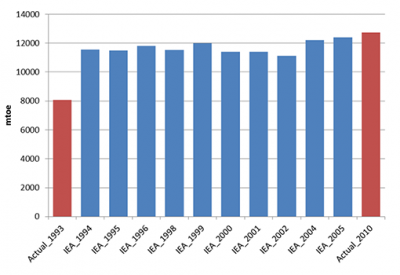Sergey Paltsev
Energy scenarios are a useful tool for industry experts, government officials, academic researchers and the general public to assist in policy-making, planning and investment decisions. Such scenarios provide projections on a wide range of issues, including production, consumption, trade, prices, investments, technology mixes, and many others. The need to transition to a low-carbon economy has added a new and challenging dimension to long-term energy scenarios development.
A recent MIT CEEPR Working Paper authored by Sergey Paltsev, Senior Research Scientist with MIT CEEPR and Deputy Director of the MIT Joint Program on the Science and Policy of Global Change, reviews the value and limits of energy scenarios and, in particular, assesses how new low-carbon goals are reflected in the latest projections. A relatively new dimension in modern energy forecasts, such policy objectives related to climate change mitigation join traditional factors such as technology development, demographic trends, and economic, political, and institutional considerations. They introduce additional variables regarding the coverage, timing, and stringency of policies to mitigate greenhouse gas emissions and air pollutants.
International decisions – such as the Paris Agreement – that articulate the need to mitigate climate change render energy projections particularly important, as they call for a future energy system based on a radically different fuel mix compared to historic energy developments. Mitigating energy-related greenhouse gas (GHG) emissions (which affect the global climate system) and air pollutants (which mostly impact local environments) results in substantial challenges and opportunities for current and future pathways for energy development. Industry experts and policy makers need to understand investment requirements as well as policy design options and their implications.
Low-emitting technologies will be necessary to mitigate climate change and air pollution, and such technologies are likely to drastically transform energy production and consumption patterns in coming decades. Responding to this challenge, many energy scenarios therefore not only provide estimates regarding future developments under a given or expected policy framework, but they also can yield insights on the required changes to the energy system in order to achieve certain climate and environmental targets.
Modern tools used for energy scenario development offer a good basis to estimate such systemic changes needed to achieve specified mitigation targets. Scenario analysis often includes energy paths consistent with different policies. In many cases, however, this leads to an increase in the uncertainty ranges of forecasts, whereas policy makers often prefer to see a discrete number instead of a range of outcomes. While academic literature embraces uncertainty, the wide range of outcomes leads to a prevalent perception by the general public that scenarios do not offer much more than a statement that “almost anything is possible”.
When ascertaining the value and limitations of energy scenarios, it is generally easier to find the limits. This is not only true of energy projections, but also of any other prediction of the future: financial, economic or political. Forecasts of all sorts are usually not very successful at predicting sudden changes. A move to a low-carbon energy future requires a drastic change in energy investment and the resulting mix in energy technologies. If history is any guide, energy scenarios overestimate the extent to which the future will look like the recent past.
Still, an argument can be made regarding the value of improvements, simplifications, or inclusion of additional detail to strengthen the models underlying an energy scenario. Most energy scenarios offer plausible futures, rather than trying to identify the most likely future. The need for low-emitting technologies will shift the current technology mix, but the exact contribution of particular technologies and the timing of this shift depend on many economic and political variables. Such uncertainty about the commercial availability of different technologies and their cost over time supports the conclusion that governments should not try to pick “winners”, and instead focus policies and investment on targeting emissions reductions from any energy source. Energy scenarios may not provide the exact projections, but they are the best available tool to assess the magnitude of challenges that lie ahead.

Figure 1. Projected global energy demand for 2010 (in blue) and actual global energy demand for 1993 and 2010 (in red). Data Source: IEA World Energy Outlooks for 1994-2005 (there was no Outlook in 1997 and the 2003 Outlook used 2002 projections).



